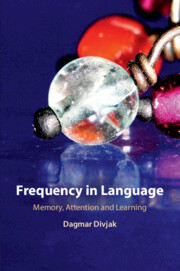Crossref Citations
This Book has been
cited by the following publications. This list is generated based on data provided by Crossref.
Nölle, Jonas
Fusaroli, Riccardo
Mills, Gregory J.
and
Tylén, Kristian
2020.
Language as shaped by the environment: linguistic construal in a collaborative spatial task.
Palgrave Communications,
Vol. 6,
Issue. 1,
Pleyer, Michael
and
Hartmann, Stefan
2020.
Construction grammar for monkeys?.
Evolutionary Linguistic Theory,
Vol. 2,
Issue. 2,
p.
153.
Dąbrowska, Ewa
2020.
Language as a phenomenon of the third kind.
Cognitive Linguistics,
Vol. 31,
Issue. 2,
p.
213.
Sommerer, Lotte
2020.
Why we avoid the ‘Multiple Inheritance’ issue in Usage-based Cognitive Construction Grammar.
Belgian Journal of Linguistics,
Vol. 34,
Issue. ,
p.
320.
Caldwell‐Harris, Catherine L.
2021.
Frequency effects in reading are powerful – But is contextual diversity the more important variable?.
Language and Linguistics Compass,
Vol. 15,
Issue. 12,
Mansfield, John
2021.
The word as a unit of internal predictability.
Linguistics,
Vol. 59,
Issue. 6,
p.
1427.
Hartmann, Stefan
and
Pleyer, Michael
2021.
Constructing a protolanguage: reconstructing prehistoric languages in a usage-based construction grammar framework.
Philosophical Transactions of the Royal Society B: Biological Sciences,
Vol. 376,
Issue. 1824,
Baumann, Andreas
Kaźmierski, Kamil
and
Matzinger, Theresa
2021.
Scaling Laws for Phonotactic Complexity in Spoken English Language Data.
Language and Speech,
Vol. 64,
Issue. 3,
p.
693.
Sláma, Jakub
2021.
The study of valency is biased toward more frequent verbs: A corpus study of the valency of less frequent verbs in Czech.
Journal of Linguistics/Jazykovedný casopis,
Vol. 72,
Issue. 2,
p.
434.
Stein, Simon David
and
Plag, Ingo
2021.
Morpho-Phonetic Effects in Speech Production: Modeling the Acoustic Duration of English Derived Words With Linear Discriminative Learning.
Frontiers in Psychology,
Vol. 12,
Issue. ,
McConnell, Kyla
and
Blumenthal-Dramé, Alice
2021.
Usage-Based Individual Differences in the Probabilistic Processing of Multi-Word Sequences.
Frontiers in Communication,
Vol. 6,
Issue. ,
Deppermann, Arnulf
and
Pekarek Doehler, Simona
2021.
Longitudinal Conversation Analysis - Introduction to the Special Issue.
Research on Language and Social Interaction,
Vol. 54,
Issue. 2,
p.
127.
Heinemann, Sabine
2021.
Hochfrequenz und Irregularität – zur Stammallomorphie bei (a)frz. al(l)er/(a)it. andare, (a)frz. venir/(a)it. venire und afrz. ester/(a)it. stare
.
Zeitschrift für romanische Philologie,
Vol. 137,
Issue. 4,
p.
961.
Gedik, Tan Arda
2021.
An analysis of lexicogrammatical development in English textbooks in Turkey: A usage-based construction grammar approach.
ExELL,
Vol. 9,
Issue. 1,
p.
26.
Kostadinova, Viktorija
Wiemann, Marco
Dreschler, Gea
Gregersen, Sune
Gyuris, Beáta
Zhong, Ai
Scott, Maggie
Anderwald, Lieselotte
Hansen, Beke
Leuckert, Sven
Kraš, Tihana
Ting, Shawnea Sum Pok
Cogo, Ida Parise Alessia
Reber, Elisabeth
and
Ahmed, Furzeen
2021.
I English Language.
The Year's Work in English Studies,
Vol. 100,
Issue. 1,
p.
1.
Sommerer, Lotte
and
Baumann, Andreas
2021.
Of absent mothers, strong sisters and peculiar daughters: The constructional network of English NPN constructions.
Cognitive Linguistics,
Vol. 32,
Issue. 1,
p.
97.
Nesset, Tore
2022.
Language Change and Cognitive Linguistics.
Stein, Simon David
and
Plag, Ingo
2022.
How relative frequency and prosodic structure affect the acoustic duration of English derivatives.
Laboratory Phonology,
Vol. 13,
Issue. 1,
SUNDQUIST, JOHN D.
2022.
An exemplar-based approach to composite predicates in the history of American English.
English Language and Linguistics,
Vol. 26,
Issue. 2,
p.
413.
Matzinger, Theresa
and
Ritt, Nikolaus
2022.
Phonotactically probable word shapes represent attractors in the cultural evolution of sound patterns.
Cognitive Linguistics,
Vol. 33,
Issue. 2,
p.
415.



